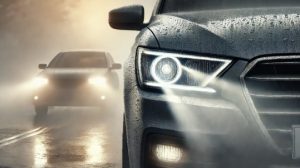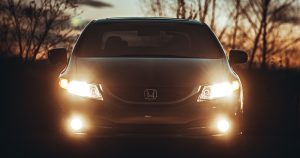Car lighting plays a crucial role in safety, visibility, and comfort on the road. It not only helps you see obstacles, road signs, and lane markings but also ensures other drivers see your vehicle. However, weather conditions like fog, rain, snow, and dust can significantly impact how well your headlights, fog lights, and other lighting systems perform. Understanding these effects and how to counter them can dramatically improve nighttime driving safety and visibility.

The Science Behind Light and Weather
Different weather phenomena affect light in unique ways. These are the three main physical effects that reduce lighting efficiency:
-
Scattering – Water droplets, dust, or snowflakes scatter light in multiple directions, weakening the beam and causing glare.
-
Backscatter – Light reflects back toward the driver in fog or heavy rain, creating a “white wall” effect and reducing visibility.
-
Absorption – Moisture, pollution, or snow absorb part of the light, reducing its reach and intensity.
The result is reduced visibility, glare, and a distorted beam pattern — all of which make driving more difficult.
Impact of Different Weather Conditions
| Weather Condition | Impact on Lighting | Result for Driver |
|---|---|---|
| Fog | Severe light scattering and backscatter | White glare, drastically reduced visibility |
| Rain | Droplets scatter light and make road surfaces reflective | Reduced contrast and road clarity |
| Snow | Snowflakes scatter light; snow on lamps blocks beams | Diffused light and poor beam focus |
| Dust / Haze | Fine particles scatter shorter wavelengths | Dim light and reduced distance visibility |
Fog and Mist: The Backscatter Challenge
Fog is one of the most challenging conditions for car lighting. The water droplets scatter light in every direction, and much of it bounces straight back to the driver. High beams, in particular, make the situation worse. Instead of improving visibility, they illuminate the fog itself.
Best practices in fog:
-
Always use low beams instead of high beams.
-
Install selective yellow fog lights — their longer wavelength cuts through fog more effectively.
-
Keep headlight lenses clean to reduce glare.
Rain: Reduced Contrast and Reflection
Heavy rain affects visibility in two ways: it scatters the light and reduces contrast by making the road surface reflective. Wet asphalt absorbs more light, while puddles and reflections can confuse the driver’s perception of distance and road markings.
Tips for rainy weather:
-
Use headlights even during daylight rain for better visibility.
-
Ensure headlamp aim is correct — poorly aimed beams can reflect into your eyes.
-
Consider adaptive headlights that automatically adjust their angle based on road conditions.
Snow and Ice: Blocked and Diffused Light
Falling snow acts like millions of small reflectors, scattering light and reducing range. Additionally, snow or ice buildup on headlights physically blocks light output and distorts the beam pattern.
What you can do:
-
Clear snow and ice from headlights before and during long trips.
-
Use lights with built-in heating elements to prevent snow accumulation.
-
Consider projector-style lamps, which focus light more efficiently in snow.
Dust, Sand, and Haze: Scattering Short Wavelengths
Dust storms or pollution can also weaken lighting. Shorter wavelengths (blue light) scatter more easily, so standard white or blue-tinted headlights lose effectiveness in dusty or hazy air.
Best strategies:
-
Use amber or yellow-tinted lights for better penetration.
-
Install auxiliary driving lights with a longer beam pattern for added visibility.
-
Clean exterior lenses regularly — dust buildup worsens scatter.
How Lighting Technology Performs in Weather
| Lighting Type | Advantages | Drawbacks in Bad Weather |
|---|---|---|
| Halogen | Warm light cuts through fog better | Lower brightness overall |
| LED | Bright, efficient, long-lasting | More prone to scatter in fog/rain |
| HID/Xenon | Very bright, excellent range | High glare and scattering potential |
| Laser | Superior distance | Expensive and not ideal for fog |
| Yellow/Amber | Best penetration in fog, dust, snow | Less intensity in clear conditions |
Tips to Maximize Lighting Efficiency in Any Weather

-
Use fog lights correctly: Only in low-visibility conditions — otherwise, they can dazzle oncoming drivers.
-
Keep lenses clean: Dirt, water spots, and salt drastically reduce beam output.
-
Check seals and housing: Moisture inside headlights scatters light and can damage components.
-
Upgrade to adaptive lighting: Smart systems adjust beam patterns based on speed, steering angle, and conditions.
-
Regularly inspect your system: Burned-out bulbs or damaged reflectors reduce effectiveness.
Final Thoughts
Weather has a direct impact on how well your car’s lighting system performs. Fog, rain, snow, and dust each present unique challenges — from scattering and absorption to glare and reduced contrast. The good news is that by choosing the right lighting technology, using proper driving techniques, and keeping your lights well-maintained, you can maintain excellent visibility and safety no matter the conditions.
If you’re planning to upgrade or replace your lighting system with components designed for harsh weather, you can Buy Car Lighting online and choose the best solutions for your vehicle.